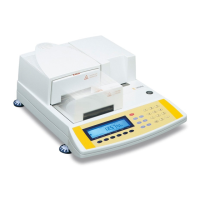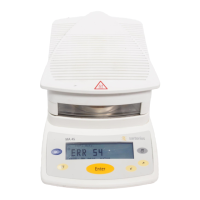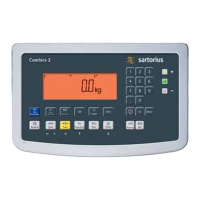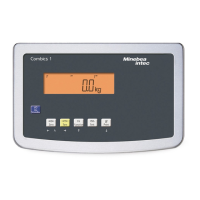Do you have a question about the Sartorius LMA100P and is the answer not in the manual?
| Capacity | 100 g |
|---|---|
| Readability | 0.001 g / 0.01% |
| Interface | RS-232 |
| Operating temperature | +10°C to +30°C |
| Power Supply | 100 - 240 V, 50/60 Hz |
| Display | LCD |
| Weighing pan size | 90 mm |
| Stabilization time (typical) | 3 s |
| Calibration | External |
| Operating Humidity | 80 % relative humidity, non-condensing |
Explains safety symbols and their meanings, including Danger, Caution, and Note.
Warns about potential radio interference in domestic environments and required user measures.
Specifies allowable temperature ranges for storage and shipping of the analyzer.
Provides guidance on safely unpacking the instrument and checking contents.
Details components of the heater module with numbered designations.
Details components of the control module with numbered designations.
Lists various cables, power connection types, and ports.
Describes connecting modules and setting up the printer for LMA100P.
Covers location requirements and connecting the analyzer to AC power.
Explains the warm-up period required for optimal analyzer performance before testing.
Describes the dedicated, numeric, navigational, and soft keys on the analyzer.
Describes the different screen states during analyzer operation: Warm-up, Standby, and Test.
Explains how to select menus, drill down for information, and return to previous screens.
Instructions for using the built-in printer, including paper loading and tearing.
Explains the meaning of LED colors and patterns for status indication.
Details information displayed on the standby screen: program name, time, temperature.
Explains the capacity for storing drying programs for easy recall and use.
Describes opening the hood, placing the pan, and taring the balance before testing.
Accesses functions for creating, editing, and managing drying programs.
Explains how to edit existing program parameters and save changes.
Describes selecting units and adjusting displayed decimal places for results.
Explains how to enter scale or offset factors for result adjustment.
Describes the standard and rapid ramp rate options for temperature control.
Explains how the slope function determines the test endpoint based on weight loss.
Covers setting the delay before initial weight capture and standby temperature.
Covers setting target sample weight and equilibration time.
Defines tolerance range and lock function for ideal weight.
Enables Pass/Fail indication based on set limits for statistical process control.
Describes different test modes available: Standard, Syringe, and Concentration.
Explains how to create and set alphanumeric names for drying programs.
Describes the process of creating and storing new drying programs.
Explains how to remove unwanted drying programs from storage.
Details methods for sorting programs alphabetically or filling blank slots.
Options for printing current program parameters, the program list, and all programs.
Instructions for turning the data log on/off and viewing stored test results.
Explains how to set up operator names and enable them for printouts.
Describes how to view different graph types and print them.
Explains how to select specific content items for the results printout.
Instructions for setting the current time, date, and their display format.
Details serial port settings, baud rate, parity, and the DE-9S connector pinout.
Lists serial commands for configuring test parameters like units, temperature, and slope.
Explains how to set sleep/wake times and days for energy saving.
Describes how to enable or disable the pass code protection for the analyzer.
Instructions for erasing all stored test results from the data log.
Instructions for removing operator entries from the system.
Manages programs by clearing, saving to archive, or loading from archive.
Describes transferring programs between analyzers via serial connection.
Controls for key press, ideal weight, and end-of-test beeps.
Displays analyzer model, serial number, software versions, and calibration dates.
Procedures for internal and external balance calibration.
Describes procedures to verify and adjust heater temperature.
How to perform tests for Total Suspended Solids (TSS) in low-solid samples.
Steps for testing volatile samples using the syringe method.
How to operate multiple heater modules simultaneously from one control module.
General advice and steps for cleaning the analyzer's exterior and interior components.
How to configure temperature, time, slope, and units for TGA analysis.
Information on recycling packaging and proper disposal of electronic equipment.
Details the EU directives and European standards the analyzer complies with.











